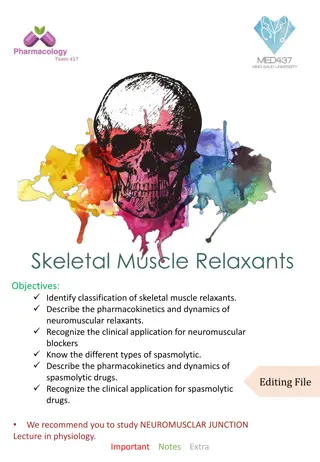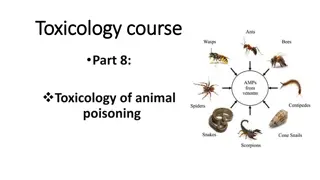Neurologic Disorder
Structural divisions of the central and peripheral nervous systems, learn about neuron anatomy, the neuromuscular junction, and the role of neurotransmitters. Includes information on Acetylcholine, Norepinephrine, Dopamine, and Serotonin.
0 views • 24 slides
SGLT-2 inhibitors and AKI
Consultant Nephrologist Paraskevi Liaveri discusses the association between SGLT-2 inhibitors and acute kidney injury (AKI). Pharmacovigilance reports highlight a higher risk of AKI with these drugs, especially when combined with RAAS blockers, diuretics, or NSAIDs. Studies suggest potential mechani
0 views • 49 slides
Overview of Antiarrhythmic Drugs Use and Classification
Antiarrhythmic drugs are classified into different classes based on their mechanisms of action. Class I includes sodium channel blockers with specific drugs like procainamide, disopyramide, and quinidine. Class 1B involves lidocaine and mexiletine. Class 1C consists of agents like flecainide. Class
2 views • 19 slides
Early Detection and Proactive DPTL Activity Operating Procedures
Coordinated multi-disciplinary team efforts are crucial in preparing patients for discharge promptly to avoid prolonged hospital stays. Early detection and proactive DPTL activity focus on identifying potential discharge obstacles as soon as patients arrive in the emergency department. Various commo
5 views • 13 slides
Skeletal Muscle Relaxants and Neuromuscular Blockade
Skeletal muscle relaxants are used to induce muscle relaxation during surgeries. Neuromuscular blocking agents act at the neuromuscular junction. These drugs can either peripherally reduce muscle tone or centrally cause muscle paralysis. Different types of muscle relaxants are classified based on th
6 views • 23 slides
Managing Sports Injuries: Prevention and Treatment Strategies
This content covers various sports injuries, ways to reduce risks, treatment of injuries including R.I.C.E method, and different drugs used in sports like anabolic steroids, beta blockers, peptide hormones, and the concept of blood doping. It also touches upon benefits, risks, and examples related t
0 views • 11 slides
Performance-Enhancing Drugs in Sports: Types and Effects
Anabolic steroids, beta-blockers, diuretics, narcotic analgesics, and peptide hormones are commonly used in sports to enhance performance. Each drug has specific advantages and disadvantages, impacting athletes' physical and mental health. While some drugs enhance muscle growth and speed up recovery
0 views • 8 slides
Understanding Strength-Duration (SD) Curve: A Neuromuscular Diagnostic Test
Strength-Duration (SD) curve is a diagnostic test assessing neuromuscular integrity by measuring the relationship between stimulus strength and duration. It helps in electro-diagnosis of peripheral nervous system disorders and evaluates nerve degeneration and regeneration. The curve is obtained by p
2 views • 17 slides
Skeletal Muscle Relaxants: Classification, Pharmacokinetics, and Clinical Applications
Skeletal muscle relaxants encompass different types, including neuromuscular blockers, spasmolytic drugs, and peripherally-acting agents. They are classified based on mechanisms of action and play crucial roles in inducing skeletal muscle relaxation for various clinical applications. Understanding t
3 views • 12 slides
Overview of Antihypertensive Agents and their Mechanisms of Action
Explore the classification of antihypertensive agents used in treating hypertension, including beta blockers, centrally acting agents, ganglionic blockers, ACE inhibitors, vasodilators, and more. Learn about the Renin-Angiotensin System, ACE inhibitors, and specific drugs like Captopril and Benazepr
0 views • 9 slides
Understanding Animal Venom and Snake Classification in Toxicology
Animal venom, particularly snake venom, contains various toxins that can have detrimental effects on the body. Different types of snake venom target specific systems, such as neurotoxic venom affecting neuromuscular junctions and hemotoxic venom impacting the cardiovascular system. Understanding the
4 views • 27 slides
Overview of Anxiety Disorders and Antianxiety Drugs
Anxiety disorders are conditions characterized by excessive worry and fear that can interfere with daily life. Common types include generalized anxiety disorder, panic disorder, phobias, and OCD. Treatment options include psychotherapy and anxiolytic drugs such as benzodiazepines, 5HT1A agonists, be
0 views • 25 slides
Understanding Flexibility: Types, Methods, and Benefits
Flexibility is the ability of joints to move within their maximum range, crucial for overall health and sports performance. It can be passive or active, and there are various methods to enhance it such as ballistic, static stretching, dynamic stretching, and proprioceptive neuromuscular facilitation
0 views • 8 slides
Cardiac Diseases in Pregnancy: Implications and Management
Normal pregnancy induces significant physiologic changes in the cardiovascular system, which can impact women with pre-existing cardiac diseases. Understanding the New York Heart Association classification scheme is crucial for assessing symptomatology during pregnancy. Rheumatic Heart Disease, part
0 views • 12 slides
Anesthesia Considerations for Neuromuscular Disorders: Overview and Management
This informative document discusses the classification of neuromuscular disorders, focusing on muscle and muscle membrane disorders such as Muscular Dystrophy. It delves into the characteristics, pathology, and clinical presentations of different types of muscular dystrophies, including Duchenne and
0 views • 42 slides
Understanding Motor Units and Neurotransmitters in Muscle Contraction
Motor units consist of a motor neuron and the muscle fibers it innervates. Neurotransmitters like acetylcholine play a vital role in stimulating muscle contraction by transmitting signals at the neuromuscular junction. This communication between neurons and muscles is essential for proper movement a
0 views • 30 slides
Understanding the Biological Basis of Human Motion and Motor Learning
In the biological basis of human motion, a series of electro-chemical-physical reactions occur at the neuromuscular junction, enabling nerve stimulation for muscle contraction. Nerve impulses for movement originate in the central nervous system or muscles, with acetylcholine transmitting impulses be
0 views • 13 slides
Understanding Cholinergic Neurons and Agonists in Pharmacology
Cholinergic neurons play a vital role in neurotransmission by utilizing acetylcholine (ACh) as a neurotransmitter. This neurotransmission involves steps like synthesis, storage in vesicles, release, receptor binding, degradation, and recycling of choline and acetate. Choline acetyltransferase cataly
0 views • 30 slides
Understanding Strength-Duration Curve in Neuromuscular Stimulation
The strength-duration curve depicts the relationship between electrical stimulus intensity and time required for minimal muscle contraction. It helps assess nerve damage in lower motor neuron lesions. Various types of curves exist based on innervation status, such as normal innervation, complete den
0 views • 15 slides
Overview of Cardiac Medications and Their Effects
This comprehensive guide covers various types of cardiac medications including anticoagulants, antiplatelet drugs, thrombolytics, and beta-blockers. It details their mechanisms of action, dosage guidelines, side effects, and contraindications. Anticoagulants prevent blood clotting, antiplatelets inh
0 views • 20 slides
Understanding Ergonomics for the Elderly: Adapting to Age-Related Changes
Our bodies and minds undergo changes as we age, necessitating adjustments in our environment to accommodate limitations. The design of everyday products often overlooks the needs of older individuals, leading to difficulties in tasks such as handling objects and sensory impairments. This article dis
0 views • 19 slides
Understanding Infant Reflexes and Their Importance in Development
Explore the world of infant reflexes with a focus on assessing, defining, and understanding their significance in children's neuromuscular health. Learn about feeding reflexes, protection reflexes, and more, as well as how to observe and interpret a child's responses to different types of reflexes.
0 views • 17 slides
Understanding Adrenergic Neuron Blockers: Mechanisms and Pharmacological Effects
Explore the mechanisms of action of adrenergic neuron blockers and classify adrenergic receptor blockers into selective and non-selective categories. Delve into the pharmacokinetic aspects and pharmacodynamic effects of these blockers, such as false transmitter formation, store depletion, release in
0 views • 29 slides
Pharmacotherapy for Heart Failure: A Comprehensive Review
In heart failure management, drugs play a crucial role in reducing preload and afterload, increasing cardiac contractility, and improving overall outcomes. Common drug classes include diuretics, aldosterone antagonists, ACE inhibitors, ARBs, beta-blockers, and vasodilators. These medications help al
0 views • 8 slides
Computer Forensics: Capturing and Verifying Evidence
This guide focuses on the process of capturing and verifying digital evidence in computer forensics. Topics include creating forensic images of hard drives, using forensically sound methods, imaging internal hard drives, utilizing hardware write blockers, different types of forensic images, hashing
0 views • 28 slides
Understanding Health-Related and Performance-Related Fitness Components in Sports Science
Distinguishing between health-related and performance-related fitness components is crucial in understanding how fitness impacts success in sports. Health-related factors are physiologically based, influencing an individual's ability to meet physical demands, while skill-related factors are based on
0 views • 75 slides
Understanding Neuromuscular Transmission and Drug Effects on Frog Rectus Abdominis
The content explores the neuromuscular transmission process in frog rectus abdominis, focusing on the release of Ach and its effects on Nm receptors. It also discusses the impact of different drugs on skeletal muscles, both centrally and peripherally acting, including those that act presynaptically
0 views • 12 slides
Optimizing Foundational Treatments for HFrEF: Guideline Recommendations and Implementation Strategies
Highlighting the current guideline recommendations for treating patients with Heart Failure with Reduced Ejection Fraction (HFrEF), this educational slide module emphasizes the importance of implementing the recommended therapies effectively. It covers the foundational treatments recommended by vari
0 views • 28 slides
Enhancing Reflective Practice: Understanding, Application, and Importance
Explore the concept of reflection through Johns' perspective, understanding its levels, benefits, and challenges. Discover how reflective practice empowers practitioners to enhance learning, development, and patient care quality. Identify blockers to reflection and strategies to overcome them.
0 views • 12 slides
Understanding Myasthenia Gravis: Symptoms, Diagnosis, and Management
Myasthenia Gravis (MG) is a neuromuscular disorder characterized by muscle weakness and fatigability due to a decrease in acetylcholine receptors at neuromuscular junctions. It primarily affects individuals in two age peaks, with different symptoms and gender predominance. The cardinal feature is we
0 views • 25 slides
Understanding Neuromuscular Junction Disorders with Dr. Hana Albulaihe
An in-depth exploration of neuromuscular junction (NMJ) anatomy, physiology, and associated disorders by Dr. Hana Albulaihe, a renowned Consultant Neurologist. The NMJ comprises the axon terminal of a motor neuron and the motor end plate of a muscle fiber. Disorders discussed include Myasthenia grav
0 views • 75 slides
Understanding Muscle Relaxants: Mechanisms and Applications
Muscle relaxants play a crucial role in managing conditions like spasticity and painful spasms. Centrally active agents modulate motor impulses in the spinal cord and CNS, while peripherally active agents target neuromuscular junctions. Baclofen, benzodiazepines, and other specific drugs serve vario
0 views • 13 slides
**Understanding Portal Hypertension: Causes, Symptoms, and Treatment**
Portal hypertension is a serious condition often associated with cirrhosis. Causes include cirrhosis and non-cirrhotic conditions. Symptoms range from asymptomatic to complications like variceal hemorrhage, ascites, and splenomegaly. Preventive measures, such as nonselective beta-blockers, are cruci
0 views • 14 slides
Specialised Commissioning for Congenital Myasthenic Syndromes - Overview by Professor Jacqueline Palace
Delve into the highly specialised commissioning of Congenital Myasthenic Syndromes by Professor Jacqueline Palace from the Nuffield Department of Clinical Neurology at John Radcliffe Hospital, Oxford. Explore key messages, learning objectives, and disclosures related to diagnosing, differentiating,
0 views • 4 slides
Understanding Skeletal Muscle Relaxants and Muscle Contraction Mechanisms
Skeletal muscle relaxants play a crucial role in relaxing muscles without affecting consciousness significantly. They are classified into neuromuscular blockers and spasmolytics, each targeting different mechanisms in the body. Muscle contraction occurs through the release of acetylcholine and the s
0 views • 27 slides
Differential Diagnosis of Infant with Sudden Onset Weakness and Neurological Symptoms
A 2-month-old infant presented with sudden onset weakness in all four limbs following an upper respiratory tract infection. Clinical findings include froglike posture, diminished tone in all limbs, absent reflexes, and cranial nerve involvement. Possibilities include brainstem encephalitis, myelitis
0 views • 29 slides
Overview of Skeletal Muscle Relaxants and Neuromuscular Blockers
Skeletal muscle relaxants and neuromuscular blockers are important drugs used to induce muscle relaxation. They are classified based on their site of action and mechanism of action. Understanding their classification, pharmacokinetics, and clinical applications is crucial for medical professionals.
0 views • 25 slides
Debugging Blocker in Entity Matching using MatchCatcher
Explore how the MatchCatcher solution helps identify and improve matches killed off by blockers in the entity matching process. The solution allows users to quickly find and analyze these matches, enhancing the efficiency of the blocking stage in entity matching.
0 views • 24 slides
Rational Management of Metastatic Castration-Resistant Prostate Cancer: Treatment Insights and Options
Experts discussed various treatment options for a 60-year-old patient with mCRPC, including switching to Lutetium therapy after progression on Apalutamide. Genetic testing, avoiding back-to-back hormonal therapies, and considering novel AR-blockers like Lutetium-PSMA and PARP inhibitors were highlig
0 views • 6 slides
Management of Benign Prostatic Hyperplasia (BPH) in Men: Diagnosis and Treatment Guidelines
Benign Prostatic Hyperplasia (BPH) is a common urological problem in men, especially those over 45 years old. This article discusses the diagnosis and management of BPH, including symptoms, impact on quality of life, diagnostic steps, lifestyle modifications, medication options like alpha blockers a
1 views • 15 slides







































